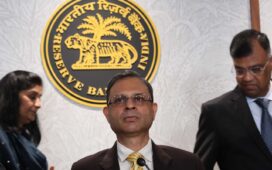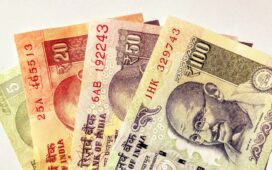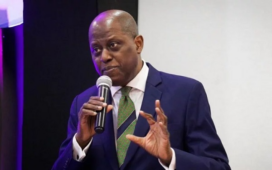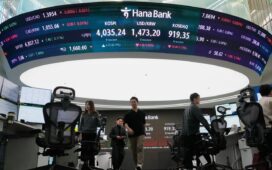South Korean authorities on Tuesday sold as much as $1bn to shore up the won, according to currency traders in Seoul, underlining concerns in several Asian countries about weakening currencies in the face of oil-fuelled inflation.
With inflation last month at a seven-year high of 4.9 per cent, Lee Myung-bak, South Korea’s president, told his cabinet to make price stability a priority.
The government “hopes the foreign currency trend will not interfere with stable prices”, Choi Jong-ku, head of the finance ministry’s international finance bureau, said in a statement on Tuesday.
South Korea’s predicament is shared by other Asian nations that have seen an abrupt currency reversal compound inflationary pressures as oil and food prices remain near record highs. For the second time this month India on Tuesday raised its key lending rate, or repo rate, by 50 basis points to 8.5 per cent to cool inflation, which is running at a 13-year high.
Seoul is the world’s fifth-largest crude oil importer, a dependency that is forcing Mr Lee’s government to shelve an election-winning pledge to boost growth, in order to contain inflation.
Although the market intervention – the second in a week – helped the won recoup about half a percentage point against the dollar, it remains among five Asian currencies that have fallen by 7 per cent or more this year against the dollar. The won is down 9.4 per cent, the worst performer after the Thai baht, which has lost 11 per cent against the dollar this year.
“There is now a significant inflation problem [in Asia] and it’s pretty clear that you don’t want your currency to be weakening in that environment because it amplifies the pressures,” says Duncan Wooldridge at UBS. “Twelve months ago everybody was trying to fight appreciation; now they are trying to fight depreciation.”
Asian countries have the ammunition for such a fight after amassing record foreign exchange reserves since the 1997 Asian financial crisis. While China is the world’s runaway leader, India and South Korea have, respectively, about $300bn and $260bn in reserves.
The Philippines, where inflation reached a nine-year high of 9.6 per cent last month,
raised reserves to $36.6bn last month from $33.7bn at the end of 2007.
In practice, however, central bankers are preparing investors for further rate rises rather than dollar sales as a way to damp inflation. Amando Tetangco, central bank governor of the Philippines, told the Financial Times that his goal was not to target the exchange rate but to calm excessive currency fluctuations.
He underlined the possible currency benefits of further Asian monetary tightening: “Inflation may continue on its up trend and, as central banks adjust their policy rates, this could have a positive impact on exchange rates.”
In some countries, currency intervention is already coinciding with monetary tightening. The Reserve Bank of India’s recent rate increases have also been aimed at providing support to the rupee, according to economists. So far this year, the rupee is down 8.3 per cent against the dollar.
Morgan Stanley said it expected the RBI to “intervene [in the currency market] in the near term …if the trade-weighted US dollar continues to rise”.
In Indonesia, where interest rates have been raised in two consecutive months, HSBC estimates Bank Indonesia bought $2.6bn of rupiah in May, the largest intervention by the central bank since June 2006.
In Thailand, Surapong Suebwonglee, finance minister, recently said the central bank should consider using the currency as a tool to fight inflation, which hit 7.5 per cent in May. The central bank, however, has rebutted suggestions that it is seeking to slow the currency’s depreciation as an anti-inflationary measure, saying it is merely trying to “stabilise” the currency.
Patrick Bennett, Asian currency strategist at Société Générale, said he expected Asian central banks to restrict efforts to “adding liquidity and smoothing [currency] moves rather than trying to draw a line in the sand”, which could prove futile.
“A lot of central banks have been very active over the last few weeks but it’s just not wise for any central bank to try to stop a currency moving from a particular level,” he said. “Their huge reserves are a real source of financial strength now, so to give those away would be unwise.”
Additional reporting by Song Jung-a in Seoul, Roel Landingin in Manila, Joe Leahy in Mumbai, Lisa Murray in Jakarta, Amy Kazmin in Bangkok and John Burton in Singapore
…………………………………
China’s exchange rate management keeps economists guessing
While many Asian governments say they want to use higher exchange rates to limit inflation, some economists think China may have cooled on the idea, writes Geoff Dyer in Beijing.
In November, when inflation in China was accelerating, the authorities began to increase the pace at which the renminbi was appreciating against the US dollar, so that the currency was strengthening at an annualised rate of nearly 20 per cent in the first quarter.
Since mid-April, however, the pattern has changed, with a period when there was virtually no change in the exchange rate followed by renewed but slower appreciation. At last week’s China-US summit in Annapolis, Chinese officials complained about the sharp decline in the value of the US dollar, prompting further talk of a change in strategy in Beijing.
Many observers have pointed out that the slowdown in renminbi appreciation coincided with sharp criticism within China about the difficulties faced by some exporters because of the stronger currency, a new labour law and tougher environmental regulations.
“There have been increasing voices raised throughout the government warning against rapid appreciation and sometimes even urging depreciation,” says Barry Naughton, professor of Chinese economics at the University of California in San Diego, although he notes that these higher costs have not prevented exports from growing strongly.
Management of the exchange rate has also been complicated by a huge surge in capital inflows this year, some of it “hot money” betting on a stronger renminbi.
The slower appreciation against the dollar could be a signal to discourage speculators.
Yet a handful of economists believe that the best way to limit speculation would be a one-off jump in the currency or a much more rapid appreciation.
According to Lawrence Goodman at Bank of America, China’s current methods for absorbing capital inflows – sterilisation through bond issues and higher reserve requirements – might be reaching their limit. “There is some possibility that the central bank will enter a new phase characterised by a more swift appreciation in the currency,” he says.
Other economists say that there has been no change in the policy of quelling inflation with a stronger currency, only a shift in target. Change in the renminbi-dollar rate may have slowed, they say, but appreciation against other trading partners, such as South Korea and Japan, has accelerated.
“Currency appreciation remains a key policy priority, but on a trade-weighted basis rather than just against the US dollar,” says Stephen Green, economist at Standard Chartered.





